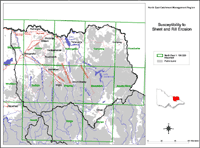Susceptibility to sheet and rill erosion
 Susceptibility to Sheet and Rill Erosion | The susceptibility of land to sheet and rill erosion is governed largely by the topsoil texture, slope of the land and length of slope. Other factors include hydrophobicity, percentage stone cover, tendency for aggregates to slake and disperse, size and weight of surface particles or aggregates and the probability of intense summer rainfalls. Soil loss from sheet and rill erosion is difficult to assess because of variability in soil loss within an area and the problem of measuring something that is not there. Sheet and rill erosion greatly reduces productivity, particularly in the case of texture contrast soils. The topsoil or A horizon is where most nutrients, organic matter, seed and macroporosity so desirable for a seedbed exists. If this is stripped away through soil loss the fertility of the soil is lost and productivity reduced. |
To view the information PDF requires the use of a PDF reader. This can be installed for free from the Adobe website (external link).
(PDF 584KB)
The land characteristics and management factors involved in sheet and rill erosion are described in Table 5.
Table 5 Land characteristics and management factors involved in sheet and rill erosion
| Processes | Land features affecting processes | Factors affected by land characteristics | Management factors that modify land characteristics |
Sheet and rill erosion occur when the forces due to rainfall, flowing water and gravity overcome the cohesion and weight of the soil particles/aggregates | Vegetation
|
| All aspects of the vegetation are affected by selection of species and control of biomass by practices such as cultivating, clearing, trafficking, fertilising, grazing, trampling, harvesting, burning |
Processes involved are:
- surface flow | Climate
|
| |
Processes involved are:
- surface flow | Geology
|
| |
Surface flow occurs on any sloping surface when the rainfall rate exceeds the infiltration rate | Topography
|
| Contour cultivating, contour banking and strip cropping reduce slope length and affect microrelief |
| Off-site effects include increased sedimentation and runon in streams and on lower lands | Soil
|
| The above management practices controlling biomass affect soil organic matter content, which in turn affects all listed soil characteristics except surface rock Direct soil compaction and disruption by trampling, trafficking and cultivating affect soil permeability, waterholding capacity and size/weight and cohesion of aggregates |


